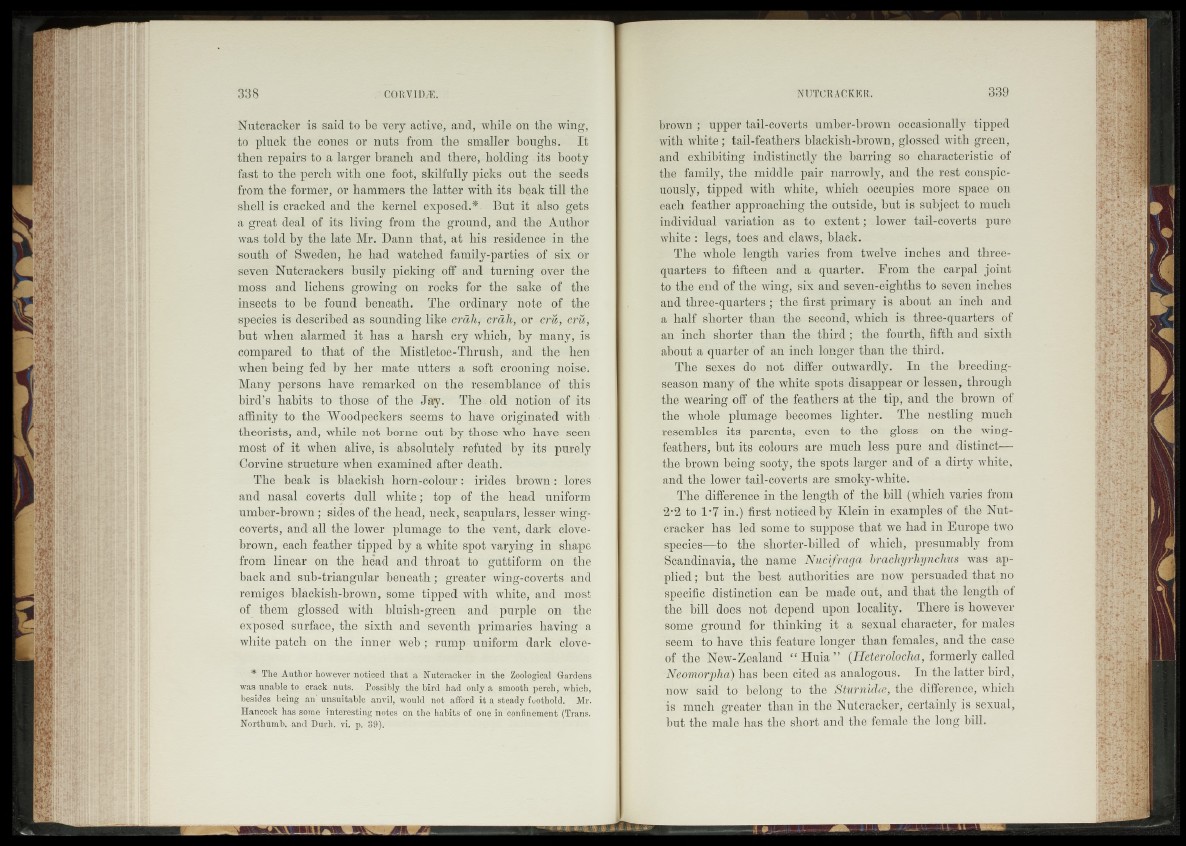
Nutcracker is said to be very active, and, while on the wing,
to pluck the cones or nuts from the smaller houghs. It
then repairs to a larger branch and there, holding its booty
fast to the perch with one foot, skilfully picks out the seeds
from the former, or hammers the latter with its beak till the
shell is cracked and the kernel exposed.* But it also gets
a great deal of its living from the ground, and the Author
was told by the late Mr. Dann that, at his residence in the
south of Sweden, he had watched family-parties of six or
seven Nutcrackers husily picking off and turning over the
moss and lichens growing on rocks for the sake of the
insects to be found beneath. The ordinary note of the
species is described as sounding like crdh, crdh, or cru, crio,
but when alarmed it has a harsh cry which, by many, is
compared to that of the Mistletoe-Thrush, and the hen
when being fed by her mate utters a soft crooning noise.
Many persons have remarked on the resemblance of this
bird’s habits to those of the Jay. The. old notion of its
affinity to the Woodpeckers seems to have originated with
theorists, and, while not borne out by those who have seen
most of it when alive, is absolutely refuted by its purely
Corvine structure when examined after death.
The beak is blackish horn-colour: irides brown : lores
and nasal coverts dull white; top of the head uniform
umber-brown ; sides of the head, neck, scapulars, lesser wing-
coverts, and all the lower plumage to the vent, dark clove-
brown, each feather tipped by a white spot varying in shap6
from linear on the head and throat to guttiform on the
back and sub-triangular beneath; greater wing-coverts and
remiges blackish-brown, some tipped with white, and most
of them glossed with bluish-green and- purple on the
exposed surface, the sixth and seventh primaries having a
white patch on the inner web ; rump uniform dark clove-
* The Author however noticed that a Nutcracker in the Zoological Gardens
was unable to crack nuts. Possibly the bird had only a smooth perch, which,
besides being an unsuitable anvil, would not afford it a steady foothold. Mr.
Hancock has some interesting notes on the habits of one in confinement (Trans.
Northumb. and Durh. vi. p. 89).
brown ; upper tail-coverts umber-brown occasionally tipped
with white ; tail-feathers blackish-brown, glossed with green,
and exhibiting indistinctly the barring so characteristic of
the family, the middle pair narrowly, and the rest conspicuously,
tipped with white, which occupies more space on
each feather approaching the outside, but is subject to much
individual variation as to extent; lower tail-coverts pure
white : legs, toes and claws, black.
The whole length varies from twelve inches and three-
quarters to fifteen and a quarter. From the carpal joint
to the end of the wing, six and seven-eighths to seven inches
and three-quarters ; the first primary is about an inch and
a half shorter than the second, which is three-quarters of
an inch shorter than the third ; the fourth, fifth and sixth
about a quarter of an inch longer than the third.
The sexes do not differ outwardly. In the breeding-
season many of the white spots disappear or lessen, through
the wearing off of the feathers at the tip, and the brown of
the whole plumage becomes lighter. The nestling much
resembles its parents, even to the gloss on the wing-
feathers, but its colours are much less pure and distinct—
the brown being sooty, the spots larger and of a dirty white,
and the lower tail-coverts are smoky-white.
The difference in the length of the bill (which varies from
2*2 to 1*7 in.) first noticed by Klein in examples of the Nutcracker
has led some to suppose that we had in Europe two
species—to the shorter-billed of which, presumably from
Scandinavia, the name Nucifraga bracliyrhynchus was applied
; but the best authorities are now persuaded that no
specific distinction can be made out, and that the length of
the bill does not depend upon locality. There is however
some ground for thinking it a sexual character, for males
seem to have this feature longer than females, and the case
of the New-Zealand “ Huia ” (Heterolocha, formerly called
Neomorpha) has been cited as analogous. In the latter bird,
now said to belong to the Stnrnidce, the difference, which
is much greater than in the Nutcracker, certainly is sexual,
but the male has the short and the female the long bill.